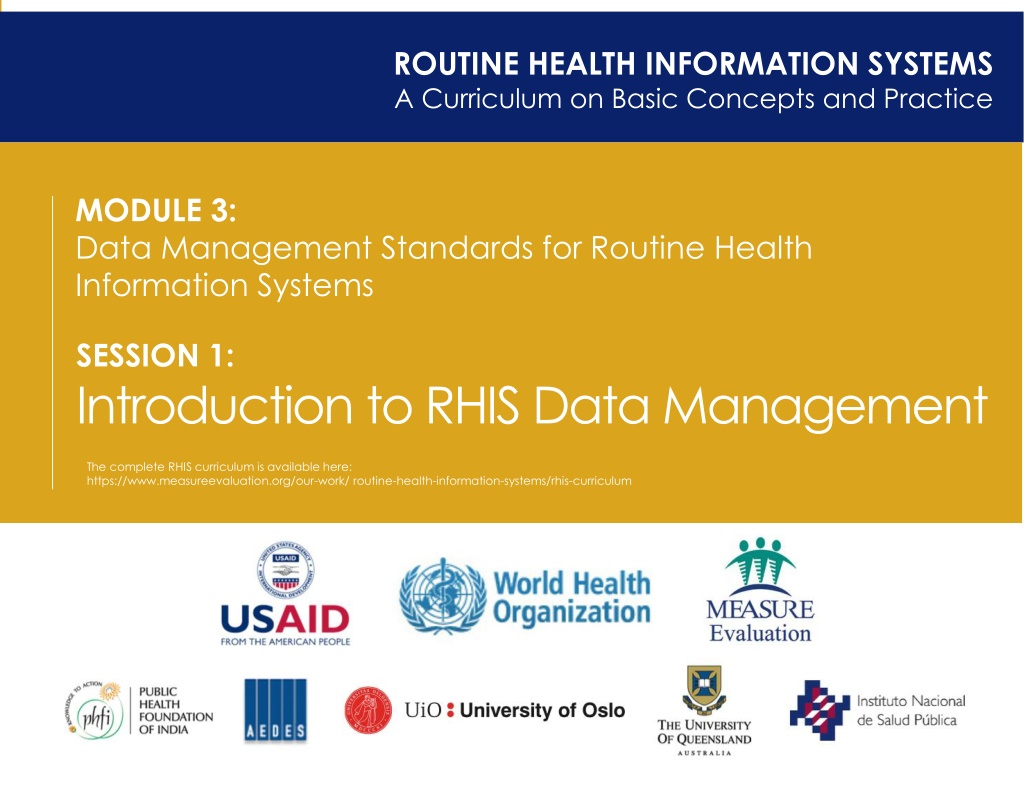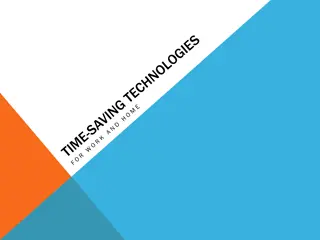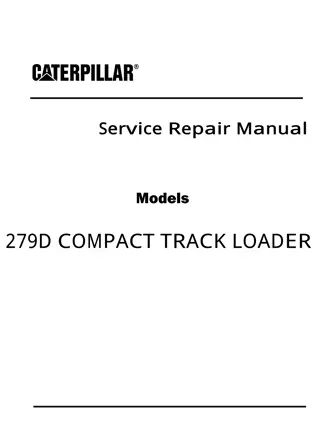
RHIS Data Management Overview and Best Practices
Learn about the importance of good data management practices in Routine Health Information Systems (RHIS). Explore data management needs at different levels and understand how standards-based approaches can enhance RHIS performance.
Download Presentation

Please find below an Image/Link to download the presentation.
The content on the website is provided AS IS for your information and personal use only. It may not be sold, licensed, or shared on other websites without obtaining consent from the author. If you encounter any issues during the download, it is possible that the publisher has removed the file from their server.
You are allowed to download the files provided on this website for personal or commercial use, subject to the condition that they are used lawfully. All files are the property of their respective owners.
The content on the website is provided AS IS for your information and personal use only. It may not be sold, licensed, or shared on other websites without obtaining consent from the author.
E N D
Presentation Transcript
ROUTINE HEALTH INFORMATION SYSTEMS A Curriculum on Basic Concepts and Practice MODULE 3: Data Management Standards for Routine Health Information Systems SESSION 1: Introduction to RHIS Data Management The complete RHIS curriculum is available here: https://www.measureevaluation.org/our-work/ routine-health-information-systems/rhis-curriculum
Learning Objectives and Topics Covered Learning Objectives Appreciate the importance of good RHIS data management practices Describe data management needs at the three RHIS management levels Describe data management standards Understand how a standards-based approach to RHIS data management can improve RHIS performance (and help create a culture of information) Topics Covered Introduction to RHIS data management Data-management needs of the different RHIS management levels Overview of data management standards, themes, and guidelines
Importance of Data Management Good data management practices ensure that data are of high quality (reliable, consistent, and complete) as well as readily available to stakeholders. Data management entails putting personnel, policies, procedures, and organizational structures in place to ensure that data are accurate, consistent, secure, and available.
RHIS Data Management: Four Domains Management & Governance 4 DOMAINS Data & Decision Support Needs Data Collection & Processing Data Analysis, Dissemination, & Use
Data Needs are Different at Different Levels Beneficiary-Level Use Clinical practitioners need clinical data on a daily basis during primary care encounters and ward rounds and they use local laboratory and other diagnostic data to monitor patients health improvement (preventive, curative, and promotional) Facility-Level Use Facilities managers regularly need data to improve facility infrastructure, equipment, commodities, and human resources Systems-Level Use From the district level to the national level, system managers need data to monitor and plan for health service delivery: data on health status, on services provided, and on management of resources such as personnel, equipment, supplies, transport, drugs and vaccines, and finances.
Data Management at Different Health System Management Levels Beneficiary Management Level Provision of healthcare Health-Facility Management Level Health facility functions System Management Level Planning; M&E Governance Public health interventions
Information Needs and Indicators Step 1: Conduct an Analysis of Management Functions Participative analysis of management functions and decision- making processes of all levels of the health system. The analysis should take into account: Priority health problems and national goals and strategies, addressing them in national health policies and strategic plans The essential package of health services defined for prevention, promotion, and management of these priority problems Health resources (e.g., manpower, materials, and money) available for carrying out these essential services Management processes to plan, monitor, and control the services and resources Existing indicators and their current use in management and M&E
Information Needs and Indicators Step 2: Identify Information Needs and Select Indicators Information should be identified to be relevant to managing and monitoring RHIS functioning. Indicators should be SMART (Specific, Measurable, Agreed upon, Relevant, Time-Bound). Indicators should be balanced and economical, improve the quality of routine data, be operationally feasible, and meet national needs. Indicators should be extensively used to monitor and evaluate plans and must be closely aligned to the planning process.
Data Collection and Storage Health records, reports, registers, and other data collection instruments should be archived at health facilities after their use and preserved typically for five to 10 years, depending on the policy established by a country s health ministry. These data and records are useful for documenting medical histories, maintaining continuity of care, monitoring and evaluating service delivery, resolving legal disputes, and performing data quality assessments and audits.
Types of Data Storage Decision as to whether to allow clients to keep their own record cards (e.g., child health program), or whether to build and maintain appropriate facility filing and archiving systems Paper Storage Collection of individual electronic health records (EHRs) and ranges from storage on simple Excel spreadsheets to storage on standard servers or sophisticated servers in the cloud Electronic Storage A server is a system comprising software and suitable computer hardware that responds to requests across a computer network to provide, or help to provide, a network service (such as data storage) Server Hosting
Pros and Cons: Data Storage by Type TYPE PROS CONS Paper Storage (Client-Held Records) Stimulate patients to take responsibility for their own healthcare Enable clients to go to the facility of their choice Patients can lose their cards, or forget to bring them when visiting a facility. Cards get wet and deteriorate. Follow-up of chronic patients is more difficult. Paper Storage (Storage System) Keep all patients information in the facility for treatment and follow-up Storage systems need to be well- designed and properly maintained, or patients will suffer delays while records are retrieved.
Pros and Cons: Data Storage by Type TYPE PROS CONS Electronic Storage (Excel) Widely available and simple to use. Not suitable for continuous regular entry of data from multiple sources. Applications in Access, Oracle, etc. should be used. Server Hosting (Conventional ) Perform better than most cloud servers If fails, have to build a new server, reinstall the operating system, and restore data. High monthly costs Server Hosting (Cloud) Cost-efficient Almost unlimited storage Backup and recovery Quick deployment Technical issues Security in the cloud Susceptible to attack
Data Confidentiality Principles Health data must be kept confidential at service delivery sites to ensure that sick people are treated fairly and with the respect they deserve. Ensuring data confidentiality should be prioritized when data are collected, transmitted, and stored. Clear guidelines and policies specific to each level should be observed.
Data Confidentiality Rules Data should be kept in a secure location. Access permissions must be controlled. Where paper records can be taken must be limited. For example, rules should prescribe where they can be accessed and removing them from secure locations should be prohibited. Electronic records and files should be password- protected. Only aggregate data should be transmitted, because patient-level data serve little purpose at higher levels. A confidentiality agreement must be signed, and renewed annually, by all staff members who access confidential records.
Data Management Governance Definition: The development and implementation of administrative policies, procedures, and processes that define workflow, program inputs and outputs, management structure, and the methods and frequency of performance evaluation Dictates how different levels and components of the RHIS work together to achieve a common goal: high- quality health data for decision making Ensures that data are high-quality reliable, consistent, complete, and timely as well as readily available to stakeholders RHIS governance is mainly addressed in Module 7
Information Culture and Demand for Data The most visible outcome of a successful information culture is that information is in demand, valued as an important resource, and used at all levels to: Improve service delivery to clients Strengthen facility management Manage systems at that level
ROUTINE HEALTH INFORMATION SYSTEMS A Curriculum on Basic Concepts and Practice This presentation was produced with the support of the United States Agency for International Development (USAID) under the terms of MEASURE Evaluation cooperative agreement AID-OAA-L-14-00004. MEASURE Evaluation is implemented by the Carolina Population Center, University of North Carolina at Chapel Hill in partnership with ICF International; John Snow, Inc.; Management Sciences for Health; Palladium; and Tulane University. The views expressed in this presentation do not necessarily reflect the views of USAID or the United States government.










